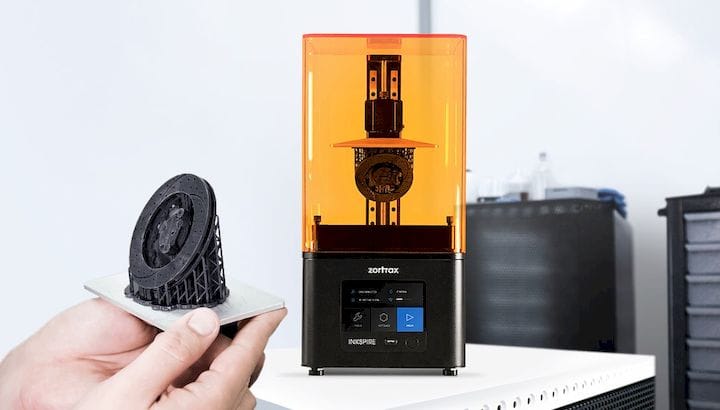![The upcoming Zortrax Inkspire resin 3D printer [Source: Zortrax]](https://fabbaloo.com/wp-content/uploads/2020/05/image-asset_img_5eb0a70b2a6e4.jpg)
Zortrax described details of their upcoming “Inkspire” 3D printer.
The company has long used filament processes for their 3D printers, but in a significant departure they’re now developing a resin 3D printer that has some interesting features.
The Inkspire uses neither lasers nor DLP as its light engine to selectively solidify photopolymer resin. Instead they are using an LCD process.
They say that while laser-based SLA approaches can provide the best resolution due to the tiny diameter of the laser, the print time can be enormous as the laser must tediously traverse all portions of each print layer. DLP approaches are faster, but due to their lens systems that stretch the tiny DLP chip’s output over a much larger resin surface, the quality of the resolution begins to break down towards the edges of the print volume.
Instead the Inkspire’s LCD system takes the best of both worlds: it’s a full panel LCD located at the bottom of the clear resin tank. Each pixel of the build volume corresponds directly, 1:1, with a specific pixel of the LCD panel.
This allows the Inkspire to do two things: It can complete building a layer simultaneously and avoid long laser traversal delays, and it can ensure consistent resolution over the entire build volume.
Zortrax explains the build volume of the Inkspire as 74 x 132 x 175 mm, a typical size for such machines. The resolution is listed at 0.05mm for XY resolution (which is in fact the LCD pixel size), and as low as 0.025mm on the Z axis. This makes for 3D prints of exceptional resolution, as seen here:
![Sample 3D prints from the new Zortrax Inkspire [Source: Zortrax]](https://fabbaloo.com/wp-content/uploads/2020/05/image-asset_img_5eb0a70b87466.jpg)
Zortrax has chosen their materials approach for the Inkspire wisely, I believe.
While they offer their own resin, currently a single rigid white material, they also offer the ability to use any third party resin, so long as it is compatible with the 405nm light wavelength used by the machine.
![The initial resin for the Zortrax Inkspire [Source: Zortrax]](https://fabbaloo.com/wp-content/uploads/2020/05/zortrax-resin_result_img_5eb0a70bcea86.jpg)
Their own material offers the possibility of Zortrax finely tuning the print parameters for optimum results without much fuss. Third party resins likely will require some experimentation to dial in on the correct settings, but at the same time allow an infinite number of resin materials to be used.
That should make everyone quite happy, and also overcome Zortrax’s initial limitation of supplying only one material.
The Inkspire includes an automated pause feature that triggers when the resin level gets too low. This allows the operator to intervene and refill the tank with additional resin and resume the print. This handy feature should eliminate some print failures.
One very interesting feature we haven’t seen on other LCD-based resin 3D printers is their leveraging of the LCD panel’s capabilities. It seems they can change print settings “on-the-fly”. I take this to mean they can do things like vary the intensity of illumination for each pixel, or the duration of illumination.
If done by individual pixel, then extreme control over the print process can be obtained. It seems that initially Zortrax is using this capability for support structures: they can be 3D printed with parameters different from the actual model.
Zortrax supports remote management on the device through its integrated WiFi connection. This feature will save some trouble when prints are going awry and can be shut down before wasting significant material.
An accessory device is to be available for the Inkspire, an ultrasonic cleaner that would remove residual resin from the print. The device uses high frequency sound waves to shake the resin off of a freshly completed print. This is quite different from some other resin print cleaners, as they tend to use alcohol to dissolve the resin, whereas the Zortrax device needs only plain water.
![It will be possible to 3D print quantities of small parts with the Zortrax Inkspire [Source: Zortrax]](https://fabbaloo.com/wp-content/uploads/2020/05/image-asset_img_5eb0a70c1d332.jpg)
It seems that Zortrax is targeting this device at professionals, such as dental operations or fine prototyping, which makes much sense. That’s a profitable market that others are eagerly pursuing, thus Zortrax should do the same.
There’s no word yet on pricing or availability, but from the looks of things it won’t be too long.
Via Zortrax










